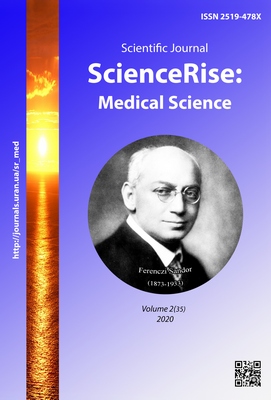Some aspects of enisamium iodide nasal spray safety: pre-clinical study results
DOI:
https://doi.org/10.15587/2519-4798.2020.199597Keywords:
acute local drug-induced irritant action, Enisamium Iodide (nasal spray), nasal endoscopy single-dose instillation, relevant scaleAbstract
The aim. To substantiate the safety using of the new nasal spray with Enisamium Iodide via study results of acute local drug-induced irritant action of the test object single-dose to eyes and nasal cavity mucosa.
Material and methods. Enisamium Iodide 10 mg/mL (nasal spray) was the test object. The reference drug was 0.9 % saline. Flemish Giant rabbits were used to induce the experiment (2 groups, 9 rabbits in each group). All study objects were administered in single-dose into the eye conjunctival sacs (0.01 mL) and nasal passages (0.1 mL) by instillation. The eye examination we performed in different time observation point (through 1, 24, 48 and 72 h after drug instillation). Nasal endoscopy was used for control of nasal cavity in all stages of study (15 minutes before, 1-hour and 24 hours after drug instillation) under general anesthesia. The scales of the assessment were used to the result objectivity.
Results. The total score was 0 points in all groups at all-time points according to the relevant scale and the scale of the assessment of rabbit nasal cavity mucosa by nasal endoscopy results. This corresponds to the condition of a healthy eye and healthy nasal mucosa.
Conclusions. Enisamium Iodide 10 mg/mL (nasal spray) in the single-dose instillation into the rabbit eye conjunctival sacs and rabbit nasal passages did not show local drug-induced irritant action on the eye conjunctiva and nasal cavity mucosa in the experimental animals. Nasal endoscopy could be used as an informative visual method in preclinical studiesReferences
- Kwah, J. H., Peters, A. T. (2019). Nasal polyps and rhinosinusitis. Allergy and Asthma Proceedings, 40 (6), 380–384. doi: http://doi.org/10.2500/aap.2019.40.4252
- Çelik, M., Kaya, K. H., Yegin, Y. et. al. (2019). Anatomical Factors in Children with Orbital Complications Due to Acute Rhinosinusitis. Iranian Journal of Otorhinolaryngology, 31 (106), 289–295.
- Sella, G. C. P., Tamashiro, E., Anselmo-Lima, W. T., Valera, F. C. P. (2017). Relation between chronic rhinosinusitis and gastroesophageal reflux in adults: systematic review. Brazilian Journal of Otorhinolaryngology, 83 (3), 356–363. doi: http://doi.org/10.1016/j.bjorl.2016.05.012
- Mengko, S. K., Soemantri, R. D., Juniati, S. H. (2018). Correlation Between Objective Evaluation Result of Nasal Congestion and Life Quality in Patients with Acute Rhinosinusitis. Indian Journal of Otolaryngology and Head & Neck Surgery, 71 (3), 1929–1934. doi: http://doi.org/10.1007/s12070-018-1333-4
- De Boer, D. L., Kwon, E. (2019). Acute Sinusitis. StatPearls. Treasure Island (FL): StatPearls Publishing. Available at: https://www.ncbi.nlm.nih.gov/books/NBK547701/
- Fokkens, W. J., Lund, V. J., Mullol, J. et. al. (2012). European position paper on rhinosinusitis and nasal polyps. Rhinology, 50 (23), 1–298.
- Ministry of Health of Ukraine. Universal clinical protocol for primary, secondary (specialized) and tertiary (highly specialized) medical care. Acute rhinosinusitis (2016). Order of the Ministry of Health of Ukraine, 85, 17–24.
- Zhulay, T. S., Shebeko, S. K., Zupanets, I. A. (2017). The study of the dose-dependent antiexudative effect of a new anti-inflammatory nasal spray. Clinical pharmacy, 21 (4), 11–16. doi: http://doi.org/10.24959/cphj.17.1446
- Zhulai, T. S. (2018). The preclinical study of a new nasal spray with the anti-inflammatory properties: the effect on the leukotriene-induced inflammation. Clinical pharmacy, 22 (4), 27–33. doi: http://doi.org/10.24959/cphj.18.1473
- Zhulai, T., Shebeko, S., Goy, A. (2018). Perspectives for use of the new nasal spray with anti-inflammatory action in treatment of acute rhinosinusitis. Rhinology, 56 (27), 585.
- Zupanets, I. A., Popovich, V. I., Zhulai, T. S., Volosovets, O. P., Shebeko, S. K., Kryvopustov, S. P. et. al. (2019). Pharmaceutical care of patients in acute rhinosinusitis treatment. Kharkiv: Golden pages, 36.
- Kovalenko, V. M., Tsypkun, O. G. (2007). Preclinical study of the local drug-induced irritant action. Kyiv: St. Pharm. Center, 13–31.
- Parliament, European & Council, European (2010). DIRECTIVE 2010/63/EU on the protection of animals used for scientific purposes. EU Official Journal. L276. Available at: https://eur-lex.europa.eu/LexUriServ/LexUriServ.do?uri=OJ:L:2010:276:0033:0079:EN:PDF
- Turner, P. V., Pekow, C., Vasbinder, M. A., Brabb, T. (2001). Administration of Substances to Laboratory Animals: Equipment Considerations, Vehicle Selection, and Solute Preparation. Journal of the American Association for Laboratory Animal Science, 50 (5), 614–627.
- Flecknell, P. A. (2016). Laboratory Animal Anesthesia. Oxford: Academic Press, 350. doi: http://doi.org/10.1016/c2013-0-13494-0
- Islam, M. A., Al-Shiha, A. (2018). Foundations of Biostatistics. Springer Nature Singapore Ltd. doi: http://doi.org/10.1007/978-981-10-8627-4
- Quirk, T. J., Quirk, M. H., Horton, H. F. (2016). Excel 2016 for Biological and Life Sciences Statistics: A Guide to Solving Practical Problems. Springer International Publishing Switzerland. doi: http://doi.org/10.1007/978-3-319-39489-3
Downloads
Published
How to Cite
Issue
Section
License
Copyright (c) 2020 Tetiana Zhulai, Igor Zupanets, Sergii Shebeko, Stanislav Zimin, Kateryna Yampolska

This work is licensed under a Creative Commons Attribution 4.0 International License.
Our journal abides by the Creative Commons CC BY copyright rights and permissions for open access journals.
Authors, who are published in this journal, agree to the following conditions:
1. The authors reserve the right to authorship of the work and pass the first publication right of this work to the journal under the terms of a Creative Commons CC BY, which allows others to freely distribute the published research with the obligatory reference to the authors of the original work and the first publication of the work in this journal.
2. The authors have the right to conclude separate supplement agreements that relate to non-exclusive work distribution in the form in which it has been published by the journal (for example, to upload the work to the online storage of the journal or publish it as part of a monograph), provided that the reference to the first publication of the work in this journal is included.









